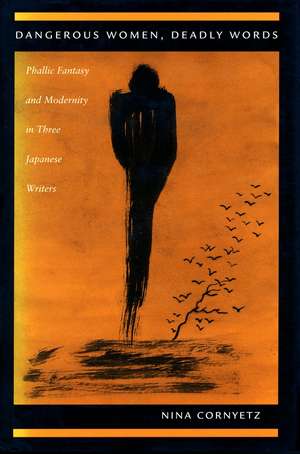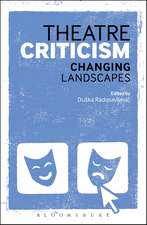Dangerous Women, Deadly Words: Phallic Fantasy and Modernity in Three Japanese Writers
Autor Nina Cornyetzen Limba Engleză Hardback – 31 dec 1998
Dangerous Women, Deadly Words is a materialist-feminist, psychoanalytic analysis of a modern Japanese literary trope—the dangerous woman—in the works of three twentieth-century writers: Izumi Kyoka (1873-1939), Enchi Fumiko (1905-86), and Nakagami Kenji (1946-92). Linked to archaisms and magical realms, the trope of the dangerous, spiritually empowered woman culls from and commingles archetypes from throughout the Japanese canon, including mountain witches, female shamans, and snake-women.
In radical opposition to the conventional interpretation of the trope as a repository for transhistorical notions of "female essence" and "Japaneseness," the author reads the dangerous woman as connected in complex ways with twentieth-century Japanese epistemological upheavals: the negotiation of modern phallic subjectivity, modernization of a homosocial economy, the radically changed status of women, reified maternity, compulsory heterosexuality, and the function of literature.
The dangerous woman enabled the literary birth of a modern, phallic, national subject as its constitutive Other, the locus of "originary" desire, thus the domain of the Lacanian Real and, accordingly, the abject. Determined by the cultural abhorrence that gives shape in language to the earliest psychic processes of separating self from not-self, the dangerous woman is also the locus for jouissance, a type of erotic pleasure that threatens the stability of the experiential subject.
The book's close literary readings are deeply anchored in the gendered cultural and literary characteristics of three periods in Japan's modernity. The author traces the trope of the dangerous woman through its establishment as a male imaginary by gothic storyteller Kyoka, its subsequent cooption for female erotic agency by Enchi, and its ultimate destabilization by Nakagami through a phallic retroping of archaisms partly dependent on an equation of the social discourses on outcaste pollution with those of homosexual and female abjection.
In radical opposition to the conventional interpretation of the trope as a repository for transhistorical notions of "female essence" and "Japaneseness," the author reads the dangerous woman as connected in complex ways with twentieth-century Japanese epistemological upheavals: the negotiation of modern phallic subjectivity, modernization of a homosocial economy, the radically changed status of women, reified maternity, compulsory heterosexuality, and the function of literature.
The dangerous woman enabled the literary birth of a modern, phallic, national subject as its constitutive Other, the locus of "originary" desire, thus the domain of the Lacanian Real and, accordingly, the abject. Determined by the cultural abhorrence that gives shape in language to the earliest psychic processes of separating self from not-self, the dangerous woman is also the locus for jouissance, a type of erotic pleasure that threatens the stability of the experiential subject.
The book's close literary readings are deeply anchored in the gendered cultural and literary characteristics of three periods in Japan's modernity. The author traces the trope of the dangerous woman through its establishment as a male imaginary by gothic storyteller Kyoka, its subsequent cooption for female erotic agency by Enchi, and its ultimate destabilization by Nakagami through a phallic retroping of archaisms partly dependent on an equation of the social discourses on outcaste pollution with those of homosexual and female abjection.
Preț: 479.52 lei
Preț vechi: 592.00 lei
-19% Nou
Puncte Express: 719
Preț estimativ în valută:
91.76€ • 96.04$ • 76.37£
91.76€ • 96.04$ • 76.37£
Carte tipărită la comandă
Livrare economică 31 martie-14 aprilie
Preluare comenzi: 021 569.72.76
Specificații
ISBN-13: 9780804732123
ISBN-10: 0804732124
Pagini: 316
Dimensiuni: 152 x 229 x 28 mm
Greutate: 0.61 kg
Ediția:1
Editura: Stanford University Press
Colecția Stanford University Press
ISBN-10: 0804732124
Pagini: 316
Dimensiuni: 152 x 229 x 28 mm
Greutate: 0.61 kg
Ediția:1
Editura: Stanford University Press
Colecția Stanford University Press
Recenzii
"Rigorous use of psychoanalytic and feminist theories, coupled with close textual analyses, make Nina Cornyetz's exploration of a literary trope of the "dangerous woman" a stimulating study. . . . Cornyetz's book marks a significant contribution, not only to the field of Japanese literary studies, but also to the psychoanalytic and feminist theories as well."—The Journal of Asian Studies
Notă biografică
Nina Cornyetz is Assistant Professor of Japanese at Rutgers University.
Textul de pe ultima copertă
“Rigorous use of psychoanalytic and feminist theories, coupled with close textual analyses, make Nina Cornyetz’s exploration of a literary trope of the “dangerous woman” a stimulating study. . . . Cornyetz’s book marks a significant contribution, not only to the field of Japanese literary studies, but also to the psychoanalytic and feminist theories as well.”—The Journal of Asian Studies
Descriere
This is a materialist-feminist, psychoanalytic analysis of a modern Japanese literary trope—the dangerous woman, linked to archaisms and magical realms and found throughout the Japanese canon—in the works of three 20th-century writers: Izumi Kyoka (1873–1939), Enchi Fumiko (1905–86), and Nakagami Kenji (1946–92).












